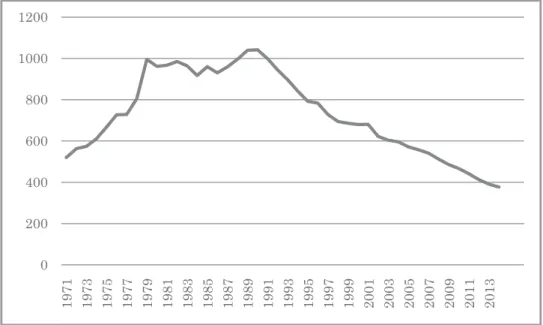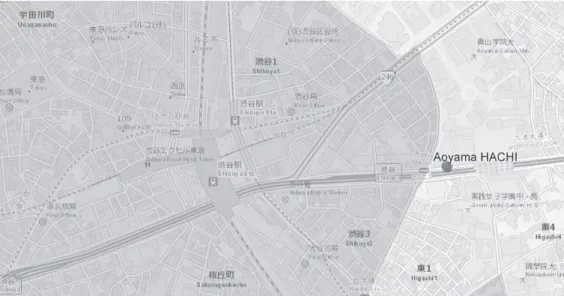How was the dance culture regulated in Japan?
The history of “Fu-ei-ho”
(act on control and
improvement of amusement business)
日本におけるダンス文化規制の歴史
――風営法関連年表――
Kenji OTA
太 田 健 二
四 天 王 寺 大 学 紀 要 第 67 号 2019年 3 月 (抜刷)1. Prehistory
Late 19th century (the Meiji Restoration)
Western (ballroom) dance have come into Japan. The style, men and women dance closely, deviated from the moral at the time.
1883
Rokumei-kan (鹿鳴館), the symbol building of Westernization (the foreign policy) was completed. Dancing parties were given there.
1887 April
The masquerade (fancy ball) in the prime minister's official residence (the scandal about Hirobumi Ito, Prime Minister) has caused the immoral impression of western dance.
1920
The first dance hall in Japan was opened in Tsurumi Kagetsu-en (鶴見花月園), the amusement park. Western dance became popular in café and bar.
1924
Dances in the parlor (café and bar) were prohibited by the Metropolitan Police Department (警視
How was the dance culture regulated in Japan?
The history of “Fu-ei-ho”
(act on control and improvement
of amusement business)
日本におけるダンス文化規制の歴史 ――風営法関連年表――
Kenji OTA
太 田 健 二
Fu-ei-ho" (Act on Control and Improvement of Amusement Business, etc.) is the law has regulated the business affecting public morals (Fuzoku Eigyo 風俗営業), also the club culture in Japan. From the word Fuzoku" (風俗), the sex industry is imagined. But Fu-ei-ho has regulated night clubs also, in other words the dance culture in Japan. By the amendment of 2015, the phrase "dance" was deleted from Fu-ei-ho, and night clubs became possible to open in the late night when a business license of "Specific entertainment restaurant business" (特定遊興飲食店営業) was got. Indeed, the "IR (Integrated Resort) Promotion Act" including the expansion of night entertainment as tourism resources for the 2020 Tokyo Olympic took effect in 2016, and the "IR Implementation Law" took effect in 2018. This paper summarizes the way of regulation on the dance culture in Japan, mainly focusing on Fu-ei-ho.
Kenji OTA
庁), for against public morals. 1928
Dance halls have increased rapidly.
Enactment of the regulation for dance halls by the Metropolitan Police Department 1940
Dance halls in Japan were closed by the sumptuary law. 1941~45
The Pacific War (WWⅡ)
2. Changes after Establishment
1945
The Recreation and Amusement Association was established, and dance halls (for the American army) were restarted.
1948
Enactment of Fu-ei-ho (Act on Control and Improvement of Amusement Business, etc.) Regulated amusement business are
1. Restaurant, Café etc. (Women serve and entertain guests there.)
待合、料理店、カフェ―その他客席で客の接待をして客に遊興又は飲食をさせる営業 2. Cabaret, Dance hall etc. (Dancing with women amuses guests)
キャバレー、ダンスホールその他設備を設けて客にダンスをさせる営業 3. Billiard parlor, Mah-jong parlor etc. (Gambling Parlor)
玉突場、まあじゃん屋その他設備を設けて客に射幸心をそそるおそれのある遊技をさせ る営業
Dancehall was considered a breeding ground of prostitution. 1951
Juvenile delinquency was on increase (the first wave). 1954
By the revision of Fu-ei-ho, Pachinko parlor was added to the amusement business. 1955
By the revision of Fu-ei-ho, Billiard parlor was excluded from the amusement business. 1959
By the revision of Fu-ei-ho, the amusement business were changed 3 to 7. 1. Cabaret etc. (Dancing, Entertainment and Drinking)
キャバレーその他設備を設けて客にダンスをさせ、かつ、客席で客を接待をして客に飲 食をさせる営業
2. Restaurant, Café etc. (Entertainment and Drinking)
3. Night club etc. (Dancing and Drinking)
ナイトクラブその他設備を設けて客にダンスをさせ、かつ、客に飲食をさせる営業 4. Dance hall etc. (Dancing)
ダンスホールその他設備を設けて客にダンスをさせる営業 5. Bar etc. (Drinking with lower illuminance)
喫茶店、バーその他の設備を設けて客に飲食をさせる営業で、総理府令で定めるところ により計った客席における照度10ルクス以下として営むもの
6. Bar etc. (blind from outside and narrow space)
喫茶店、バーその他の設備を設けて客に飲食をさせる営業で、他から見とおすことが困 難であり、かつ、その広さが 5 ㎡以下である客室を設けて営むもの
7. Mah-jong parlor, Pachinko parlor etc. (Gambling)
まあじゃん屋、パチンコ屋その他設備を設けて客に射幸心をそそるおそれのある遊技を させる営業
A reason of the increase is that late-night amusement business was considered a breeding ground of juvenile delinquency also.
1964
Juvenile delinquency was on increase (the second wave).
By the revision of Fu-ei-ho, the regulations on the late-night amusement business was strengthened, because of increase in juvenile delinquency.
1974
Spaces to enjoy dancing for young generations is getting to move to the Go-go bar and the Disco. And the style has changed to dance freely by yourself.
1979
The film "Saturday Night Fever" was released in Japan. As a result, the Disco became very popular. 1982 June
A junior high school girl who were caught by a disco in Tokyo Shinjuku was killed. 1983
Juvenile delinquency was on increase (the third wave). 1984
By the large-scale revision of Fu-ei-ho, purpose of the law, the maintenance of public order and the prevention of juvenile delinquency was specified. And, it was distinguished between the amusement business from sex industries.
Late 1980 s
Disco became to regulate oneself (ID and clothing checks), meanwhile, night clubs came into fashion among young people.
1997
Kenji OTA
1998
By the revision of Fu-ei-ho, ballroom dance classes with certified teachers were excluded. 2008 March
A graduate student was assaulted resulting in death by the night club in Osaka. 2008 ∼ 10
University students have been arrested for possession of cannabis one after another. Night clubs were mentioned as a route for obtaining cannabis.
2009 August
Noriko Sakai, the celebrity who also has played DJ was arrested for Stimulant Drug Control Law violation.
2010 January
Some trouble at night club in Osaka triggered the incident that a university student was assaulted resulting in death.
3. The Revision Movement and After Revision
2010 December
The night club in Osaka Minami (America Mura) was arrested for the first time under violation of Fu-ei-ho (unauthorized operation). Arrest of night clubs increased nationwide.
2012 April
The night club Noon" in Osaka Kita was arrested under violation of Fu-ei-ho (unauthorized operation).
2012 May
The Let s Dance campaign for collecting signatures for demanding to omit the word Dance" from Fu-ei-ho started.
2012 September
A male customer in the nightclub “Studio Flower” in Roppongi was killed. 2013 April
Club and Club Culture Conference (クラブとクラブカルチャーを守る会) was established. The first president was DJ Zeebra.
2013 May
Signatures of the Let s Dance campaign collected 155,879, and was submitted to the Diet. The parliamentary association for the promotion of dance culture was formed.
2013 August
West Club Association (WCA 西日本クラブ協会) was established. 2013 September
2013 October
The case of Noon in Osaka has come to trial. 2014 March
Night-Club Entertainment Association (NCE ナイトクラブエンターテインメント協会) was established.
2014 April
NOON in Osaka was found not guilty. 2014 May
The parliamentary association for the promotion of the dance culture published the revision bill of Fu-ei-ho. But the bill met with opposition, so has been watered down.
2014 September
Ultra Japan (Electronic Dance Music event) started in Tokyo Odaiba (sponsored by Ministry of Foreign Affairs of Japan and Japan Tourism Agency).
2014 October
A cabinet decision was made with regard to the revision bill of Fu-ei-ho. 2015 June
The revision bill of Fu-ei-ho was passed. The bill omitted the word Dance" from Fu-ei-ho, so night clubs could open midnight. However, night clubs have regulated in Fu-ei-ho, and must obtain a permission as Specific entertainment restaurant business".
2016 April
DJ Zeebra was appointed the night (goodwill) ambassador of Shibuya ward. 2016 June
Enforcement of the amendment Fu-ei-ho. 2016 December
Enactment of Act on Promotion of Development of Specified Complex Tourist Facilities Areas" (Integrated Resort: IR Promotion Act)
IR is incorporated casino gambling facilities, convention and conference facilities, recreation and amusement facilities (including night clubs), exhibition facilities, accommodation facilities and other facilities. In order to realize a highly attractive extended-stay tourism, this Act sets out necessary matters, and thereby aims to contribute to the promotion of tourism and regional economy, and aims to contribute to the improvement of fiscal.
2017 April
The parliamentary association for the promotion of night time economy was formed. 2017 December
The Committee for preparing Tokyo Night Mayor was formed. 2018 January
Kenji OTA
(unauthorized operation) by Tokyo Metropolitan Police (for the location is not in the business license area). (Fig.1)
2018 July
The IR implementation bill was passed.
There are concerns that amusement business (including the dance culture) is under the control of zoning.
4. Conclusion
The dance culture (club culture) in Japan that regulated by Fu-ei-ho has been regarded as the cause the moral panics (sex, drugs and violence). Recently, tolerance has been lost and various complaints are increasing, the zoning regulation has been strengthened. And the dance culture (club culture) in Japan is expected as tourism resources of night entertainment in IR.
―――――――――――――――――― References 神庭亮介,2015,『ルポ風営法改正――踊れる国のつくりかた』河出書房新社. 永井良和,2015,『定本 風俗営業取締り――風営法と性・ダンス・カジノを規制するこの国のあり方』河 出書房新社. クラブとクラブカルチャーを守る会,2018,クラブとクラブカルチャーを守る会ホームページ(2018年11 月29日取得,http://clubccc.org/).
Let s Dance! 署名推進委員会,2018,Let s Dance! レッツダンス ダンスカルチャーを守るために(2018年11 月29日取得,http://www.letsdance.jp/).
Daisuke Kikuchi, May 30, 2016, Nightclub Deregulation: Japan shedding 1940s morality by relaxing rules on nightclubs," The Japan Times, (Retrieved November 29, 2018, https://www.japantimes.co.jp/news/2016/05/30/ reference/japan-shedding-1940s-morality-relaxing-rules-nightclubs/).
Patrick St. Michel, June 22, 2017, One year after changes to the `anti-dancing' law, clubbers are hopeful," The Japan Times, (Retrieved November 29, 2018, https://www.japantimes.co.jp/culture/2017/06/22/music/one-year-changes-anti-dancing-law-clubbers-hopeful/).
VICE Thump, October 29, 2014, After a Long Legal Battle, Japan Finally Lifts Its Notorious "No Dancing" Law: The tourism boost that Tokyo's 2020 Olympics will bring was a major factor in the government's decision., " VICE, (Retrieved November 29, https://www.vice.com/en_us/article/vvjk9m/after-a-long-legal-battle-japan-finally-lifts-its-notorious-no-dancing-law).
This work was supported by JSPS KAKENHI Grant Number JP16K02094.
Fig. 2. “Specific entertainment restaurant business” license area in Shibuya Ward and the night club “Aoyama Hachi”
Kenji OTA

